Training and Behavior Tips for Camping Dogs: Essential Guidance for Outdoor Adventures
Taking your dog camping can add joy to your outdoor adventure, but it’s vital to ensure your canine companion is well-prepared for the experience. Proper training and behavior management are key to a successful trip. Before you venture into the wild with your four-legged friend, it’s important to develop an understanding of how to manage their behavior in an environment filled with new stimuli and potential hazards.
To ensure a safe and enjoyable camping experience for both you and your dog, it’s necessary to familiarize your pet with the new conditions they will encounter. This includes adapting to unfamiliar terrain, being calm around campfires, and respecting the presence of wildlife. Establishing commands for recall, stay, and leave-it can prove invaluable in outdoor settings. Positive reinforcement techniques can help you teach your dog how to behave in these scenarios and ensure they remain under control even when off-leash.
Moreover, preparing your dog for social interactions is critical to prevent any incidents with fellow campers and their pets. A well-socialized dog is likely to exhibit better manners and lower stress levels in the company of strangers. Training your dog to be calm around new people and animals is crucial, as it promotes a peaceful coexistence with other campers and contributes to a pleasant camping atmosphere. Always remember to consider your dog’s personality and needs when planning your training routines and outdoor activities.
Preparing Your Dog for Camping
Before setting off on a camping trip with your dog, ensuring they are prepared is essential for both their safety and enjoyment.
Vaccinations and Health Check
It’s crucial to visit your veterinarian for a comprehensive health check before camping. Ensure all vaccinations are up to date, with special attention to rabies, as wildlife encounters are possible. Keep a copy of your dog’s medical records on hand and update any necessary medications. Incorporate flea and tick protection into their routine to prevent pests.
Health Checklist:
- Vaccination record review
- Rabies vaccine confirmation
- Flea and tick preventative application
- Updated medical records
Training Basics for the Outdoors
Proper training is a cornerstone of safe camping with your dog. Teach basic commands such as “stay,” “come,” and “leave it” to maintain control in various outdoor situations. Familiarize your dog with safety gear like a life jacket or reflective harness. Remember, consistent command reinforcement leads to reliable obedience.
Training Goals:
- Master basic commands: “stay,” “come,” “leave it”
- Introduce safety gear during training sessions
- Ensure your dog responds reliably while distracted
Packing the Essentials
Pack smart by including essential items that cater to your dog’s needs. A supply of their regular dog food prevents digestive upset. Bring dog camping gear such as a durable leash, portable water bowl, and a comfortable bed. Always carry a first aid kit with ointment and eyewash.
Packing List:
- Dog food: Regular diet to sustain energy
- Safety gear: Leash, reflective harness, life jacket
- First aid: Ointment, eyewash, bandages
- Comfort: Durable bed, favorite toy
By focusing on these preparations, your camping experience can be enjoyable and stress-free for both you and your four-legged friend.
Selecting the Ideal Campsite
When planning a camping trip with your dog, the right choice of campsite is crucial for safety and enjoyment. It’s key to consider whether a campsite is dog-friendly and to account for seasonal weather conditions.
Dog-Friendly Campsites
Start by researching campsites that specifically allow dogs. National Park Service sites and local parks often have designated dog-friendly areas, but policies can vary widely. To ensure a smooth experience:
- Check the campsite’s pet policy online or call ahead to confirm.
- Look for campsites with ample open space for your dog to roam and explore safely.
- Verify that the site offers convenient waste-disposal options for maintaining cleanliness.
Considering the Weather and Season
The time of year plays a pivotal role in campsite selection.
- Summer camping requires shady areas to prevent overheating and access to water to keep your dog hydrated.
- Fall brings cooler temperatures but also unpredictability, so choose sites with shelter against sudden weather changes.
| Season | Consideration |
|---|---|
| Summer | Abundant shade, water access, cooling options. |
| Fall | Shelter availability, insulation against cold. |
Always check the weather forecast for your camping period and select a site that will protect your dog under those conditions.
Safety Considerations
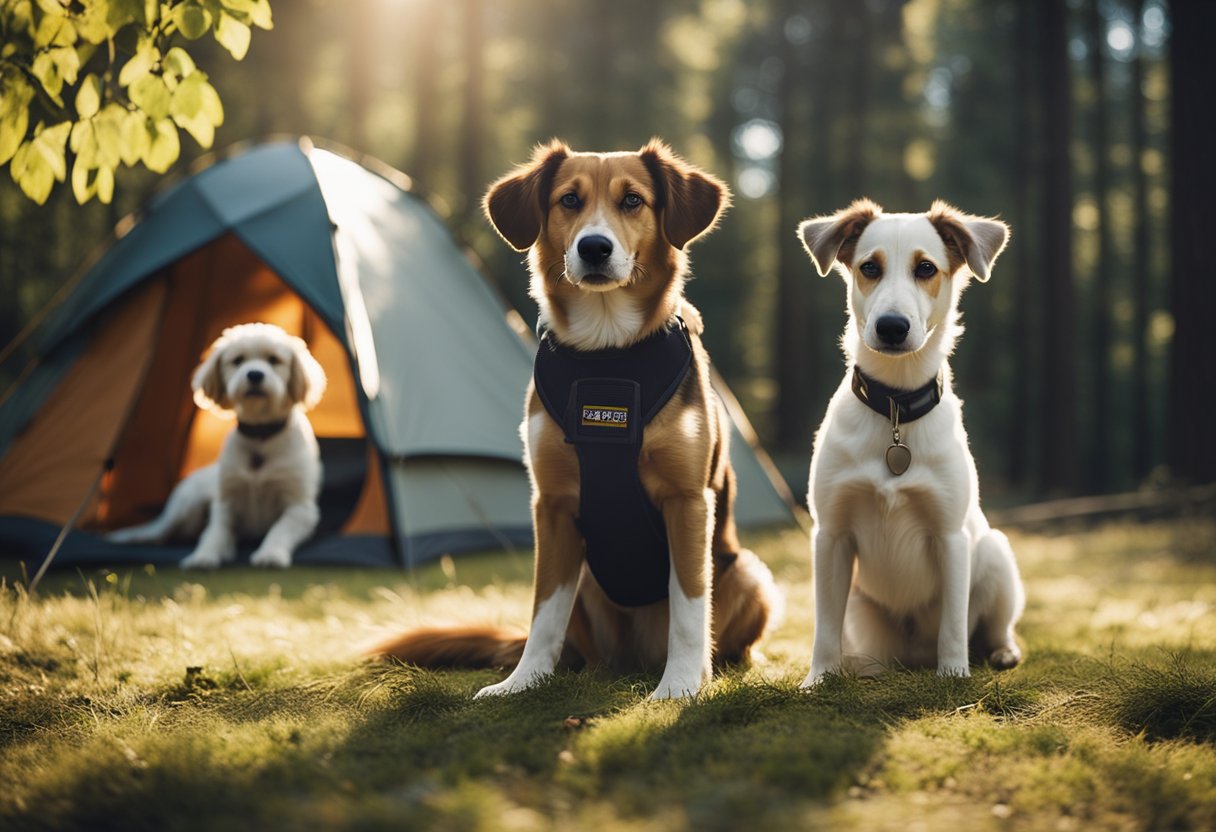
When camping with your dog, safety is paramount. You’ll need to be prepared for emergencies and knowledgeable about the regulations and good neighbor policies at your camping site.
Preventing and Handling Emergencies
Keep a pet-specific first aid kit that includes items such as tweezers for tick removal, hydrogen peroxide to induce vomiting if instructed by a vet, Benadryl for allergic reactions, and a soft muzzle to keep your pet from biting due to stress or injury. Familiarize yourself with the immediate steps to take if your dog encounters hazards, like ticks or fleas. Use a vet-recommended flea and tick prevention spray before setting out.
If a tick is found, remove it with tweezers, gripping close to the skin, and gently pulling it out, placing the tick in a sock or container for disposal. In the event of an unexpected reaction or injury, calmly administering first aid and seeking professional assistance is crucial. Always have the contact details for the nearest vet or emergency clinic.
Navigating Regulations and Neighbors
Understand and adhere to the camping area’s regulations concerning pets. Common rules often require dogs to be leashed and may restrict access to certain areas. Your dog should have proper identification, normally including a collar with ID tags and ideally microchipping.
Be considerate of your neighbors by keeping your dog’s noise level down and ensuring they do not intrude on other campers’ space. A well-behaved dog reflects well on you and helps maintain a peaceful coexistence with surrounding nature enthusiasts.
Setting Up Camp with Your Canine Companion
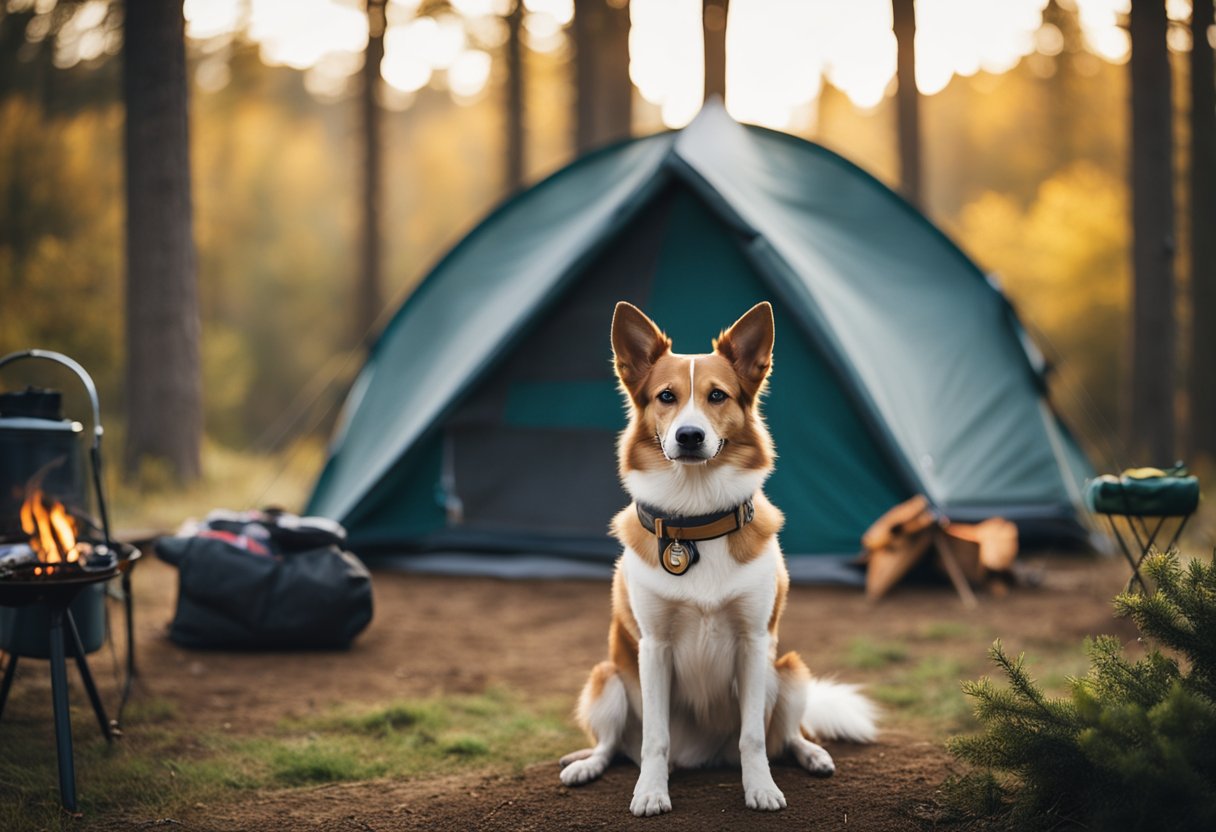
When setting up camp, it is crucial to prioritize the comfort and safety of your canine friend. Ensure that they have a cozy place to sleep and are secured at the site to enjoy the great outdoors together.
Comfortable Sleeping Quarters
To ensure a good night’s sleep for both you and your dog, prepare a comfortable sleeping area for them inside the tent. A designated dog bed provides familiarity and insulation from the cold ground. If space is a concern, opt for a foldable dog bed or a padded mat. Additionally, bring a towel or blanket that your furry friend is used to, which can help reduce anxiety and keep them warm. Check the destination’s climate and bring extra insulation if necessary.
- Sleeping Checklist:
- Dog bed or padded mat
- Familiar towel or blanket
- Extra insulation for colder destinations
Securing Your Dog at the Site
Your dog’s safety is paramount while camping. When not exploring, secure your dog using a lead or long line that allows them to move comfortably yet prevents them from wandering off or encountering wildlife. This is essential at all times, whether you’re engaging in car camping or a more rugged adventure. Have poop bags on hand to maintain cleanliness at the campsite. If participating in glamping where amenities are available, ensure your dog’s lead is compatible with the provided fixtures.
- Safety Equipment:
- Lead or long line
- Poop bags
- Compatible attachments for glamping setups
Food and Hydration
Proper nutrition and regular water intake are crucial for keeping your dog healthy and energetic during a camping trip. Ensuring that your dog has access to their regular diet and stays hydrated will enhance their camping experience.
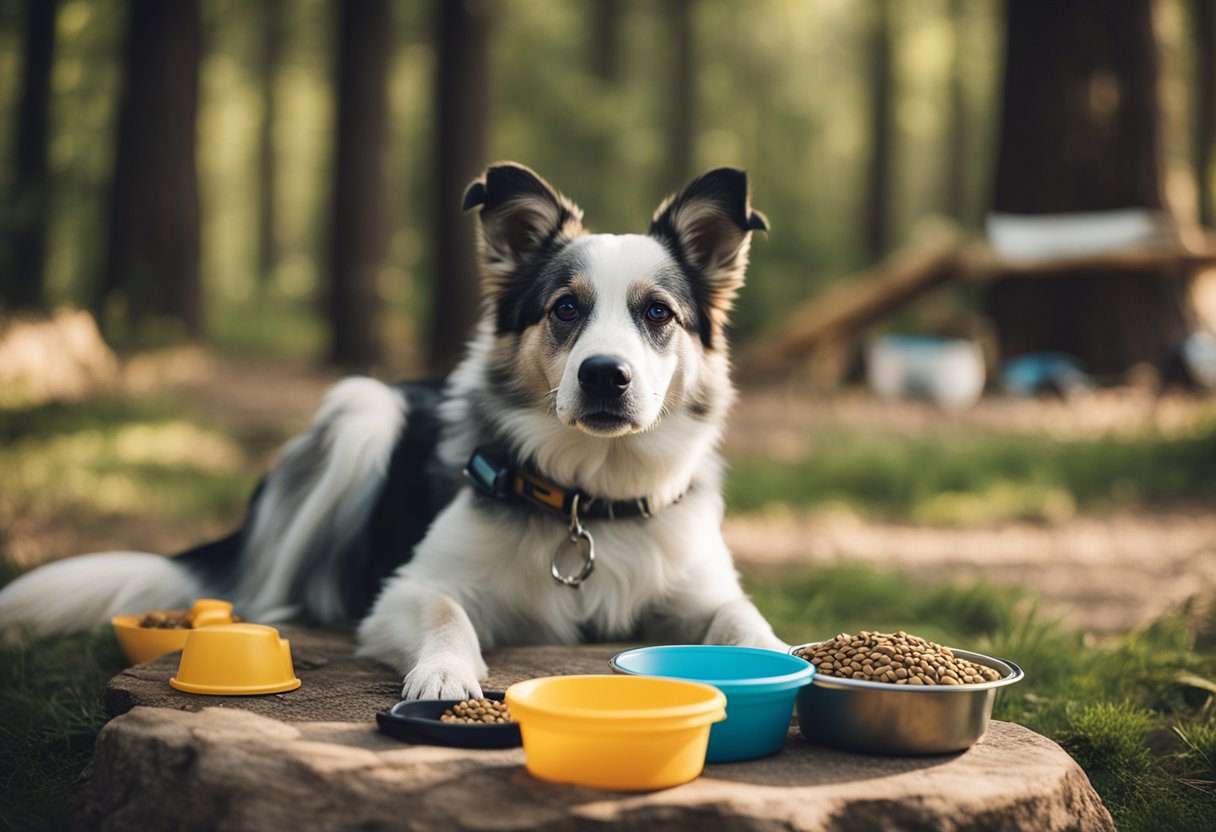
Meal Planning for Dogs
When camping with your dog, it’s essential to maintain their regular feeding routine. Calculate the amount of dog food your dog will need for the duration of your trip, taking into account any extra exercise they may get and pack a little extra. You should:
- Measure out each meal and pack them in zip-lock bags or airtight containers for freshness.
- Avoid feeding your dog unfamiliar foods to prevent digestive upset.
- Schedule meal times in accordance with your planned activities, allowing time for digestion before any strenuous exercise.
Keeping Dogs Hydrated
Hydration is even more important outdoors, where your dog may be more active than usual. Keep your dog well-hydrated by following these guidelines:
- Carry a collapsible bowl which is lightweight and portable.
- Provide constant access to fresh water, refilling the bowl frequently throughout the day.
- Monitor your dog’s hydration by checking for signs of dehydration such as dry gums and excessive panting.
- Use clean, preferably filtered water to prevent exposure to harmful bacteria or parasites that may be present in natural water sources.
By being mindful of meal planning and hydration, you’ll ensure your dog stays nourished and enjoys their time camping with you.
Activities with Your Dog
When camping with your dog, engaging in the right activities ensures both you and your canine companion enjoy outdoor adventure together safely. Remember to have their dog leash on hand for areas that require it.
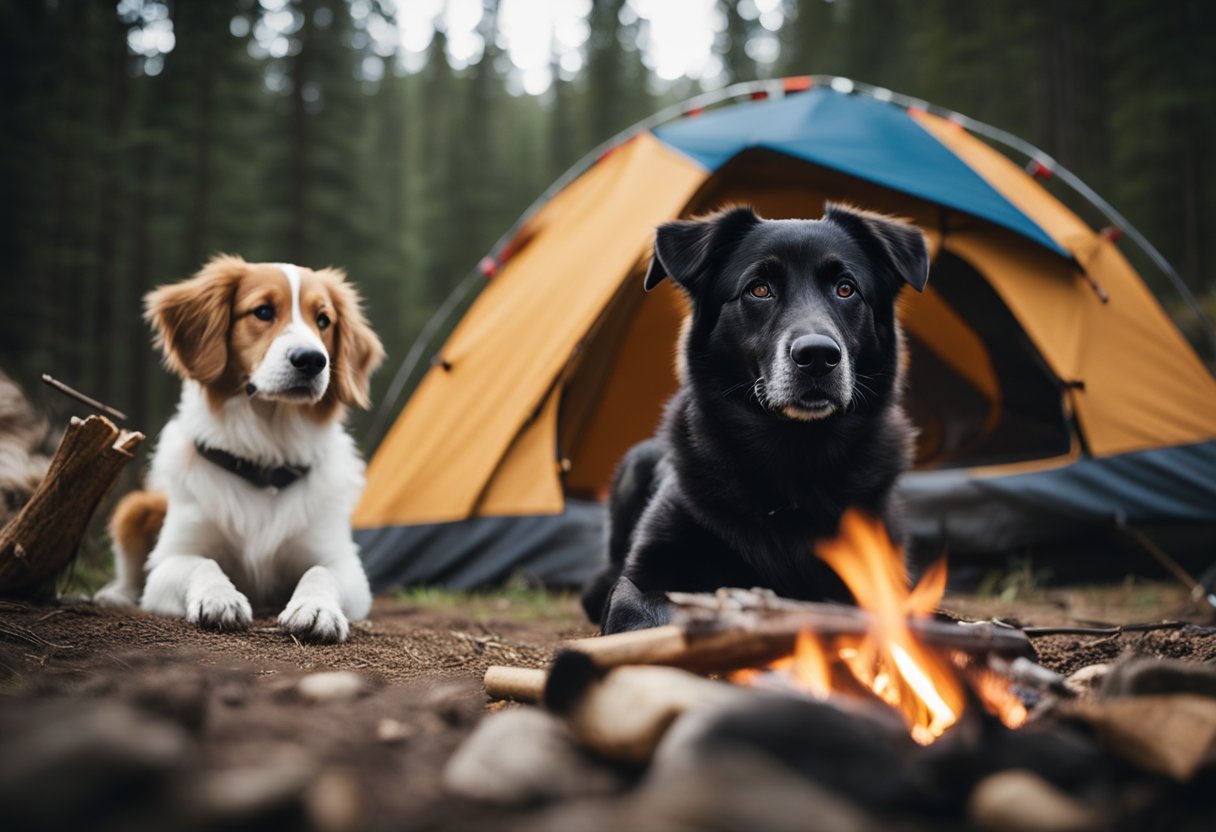
Exploring Trails and the Great Outdoors
Taking your dog on hiking trails can be exhilarating. To ensure a smooth experience:
- Check Regulations: Before you set off, make sure dogs are allowed on the trails and understand the leash laws.
- Plan Your Route: Choose trails that match your dog’s fitness level and have enough shade and water sources.
- Packing for your Dog:
- Water: Carry sufficient water and a collapsible bowl.
- First-Aid Kit: Have a basic first-aid kit for any minor injuries.
Play and Exercise at the Campsite
While at the campsite, set aside time for play and exercise.
- Fetch: Playing fetch with a ball or frisbee keeps your dog active.
- Obstacle Course: Create a simple obstacle course using natural materials like sticks and logs.
- Leash Training: Use the free time to reinforce leash training.
- Rest Periods: Remember to balance activity with rest, especially after meals or during the hottest part of the day.
Leaving No Trace
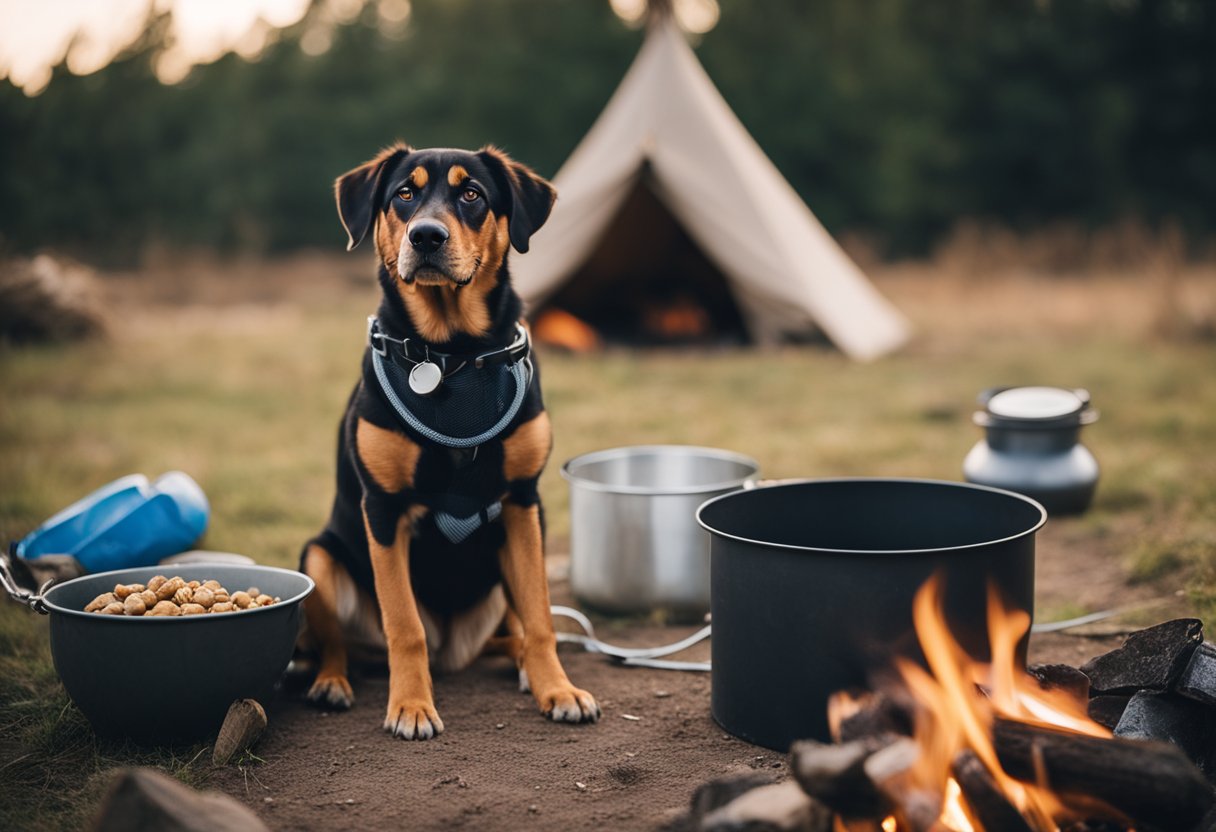
When taking your dog camping, it’s crucial to maintain the natural beauty and health of the campsite. Responsible waste management and respecting local wildlife are key components of this principle.
Waste Disposal and Cleanup
Poop Bags: Carry enough biodegradable poop bags to collect all of your dog’s waste during the trip. After use, dispose of these bags in designated trash containers or pack them out with you if no facilities are available.
- Check Regulations: Different campsites have unique rules regarding pet waste disposal. Always check the local regulations before your trip.
- Cleaning Products:
- Towel: Bring a microfiber towel for wiping dirt or mud off your dog to prevent natural sources from getting contaminated.
- Water: Use water to rinse off any remaining dirt. Avoid using soap in natural water sources.
Respecting Nature and Wildlife
- Keep Dogs on Leash: To protect wildlife, keep your dog on a leash, preventing any chance encounters or disturbances.
- Prevent Burrs and Bugs:
- Before hiking, check your dog for burrs and remove them to avoid spreading invasive plant seeds.
- Apply veterinarian-approved insect repellent that is safe for dogs to protect them from bug bites and reduce the chance of bugs being brought into the tent or car.
Post-Trip Care and Considerations
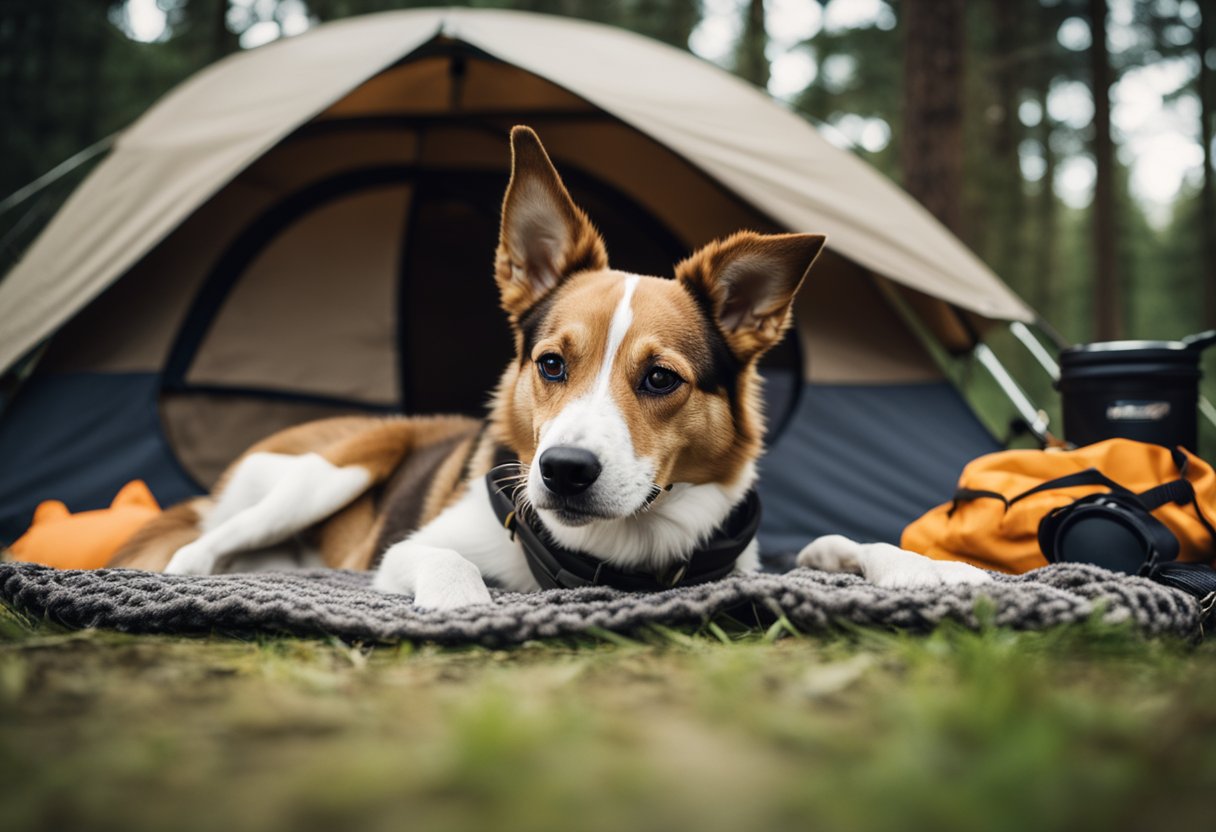
After returning from a camping trip with your dog, it’s important to address their health and well-being immediately. This includes removing potential pests they may have picked up and ensuring they recover properly from the adventure.
Checking for Ticks and Other Pests
Ticks: Ticks are a serious concern for dogs that have been camping. Once home, thoroughly inspect your dog’s coat and skin, focusing on areas like behind the ears, between the toes, and under the collar. Use a tick removal tool or tweezers to safely remove any ticks you find. Follow these steps:
- Grasp the tick as close to the skin as possible.
- Pull straight out with steady, even pressure.
- Clean the area with antiseptic ointment.
Other Pests: Look for fleas, mites, or other insects that might have attached to your dog. If you spot any signs of infestation, consider a veterinary-approved pest control product to treat your dog. Keep your vet’s contact information on hand in case you need professional assistance.
Rest and Recovery After Camping
Rest: Allow your dog to rest adequately after your trip. Provide a comfortable and quiet space for them to sleep, as they may be more tired than usual.
Recovery: Monitor your dog for any signs of overexertion or injury. Muscles can be sore, and paws may have cuts or abrasions. If you notice anything concerning, consult your vet, especially if it affects your dog’s mobility or appetite.
Remember to update your dog’s ID information if anything has changed before your next trip, and make their post-trip care as much a routine as your pre-trip preparations.
Frequently Asked Questions
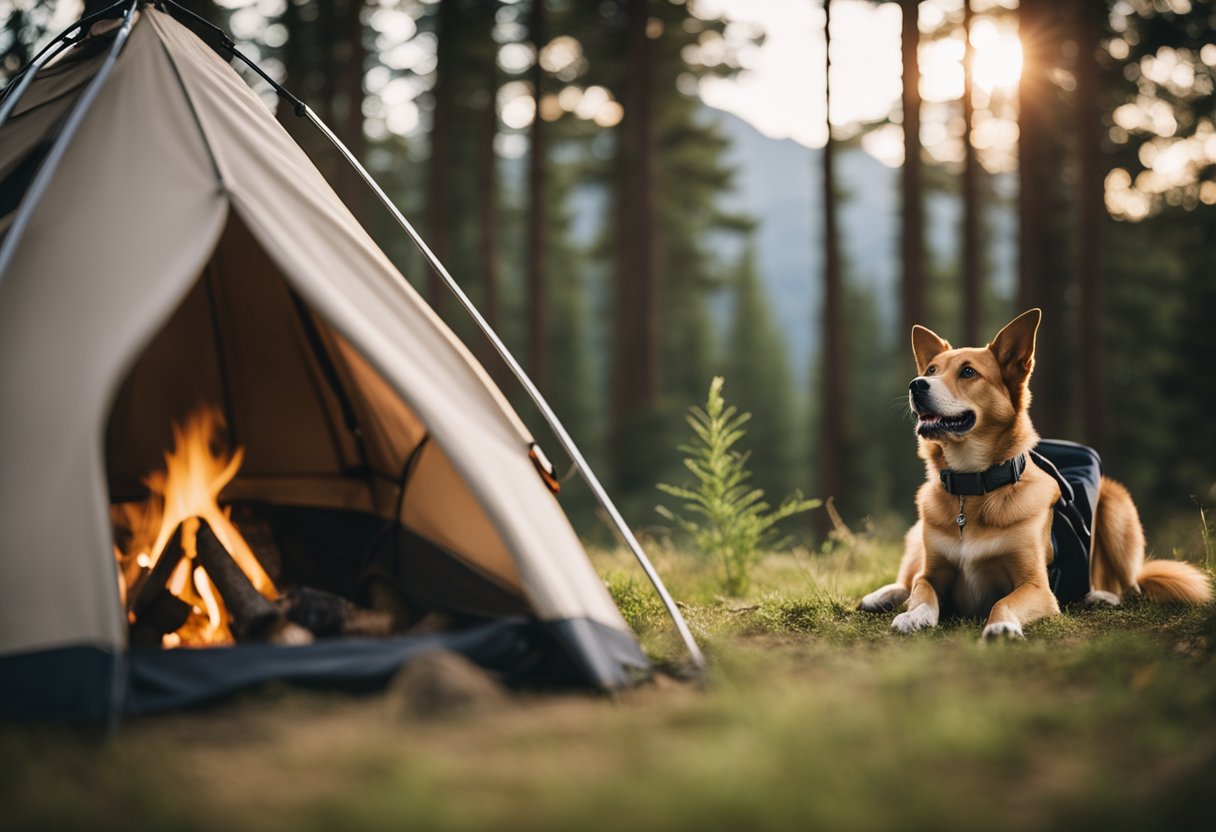
Before heading out into the wilderness, it’s important to equip yourself with practical information on preparing and managing your dog during camping trips. Here, we cover essential tips on training, safety, and care to ensure a positive experience for you and your companion.
How can I prepare my dog for their first camping experience?
Introduce your dog to the camping gear and let them sleep in a tent beforehand to become accustomed to the new environment. Practice basic obedience commands regularly to ensure they follow your instructions while outdoors.
What are some effective training techniques for dogs to behave well during camping trips?
Consistency is key in training. Use positive reinforcement methods, such as treats and praise, to reward your dog for good behavior. Train them to respond to commands like ‘stay’, ‘come’, and ‘leave it’, which are crucial in a camping context.
How should I secure my dog to ensure safety while camping?
Always use a sturdy leash or harness to keep your dog close to you, especially on trails. At the campsite, consider a tether system or a portable fence to provide your dog with freedom to move around safely within a designated area.
What essentials should I include in my checklist when camping with my dog?
Your checklist should include a leash, food and water bowls, enough dog food, waste bags, a first-aid kit, any necessary medications, and a comfortable sleeping arrangement for your dog.
Can camping cause stress to my dog and how can I alleviate it?
Camping can be stressful due to unfamiliar surroundings. Keep your dog’s routine as normal as possible, bring familiar items from home, and offer plenty of comfort and reassurance to help them relax.
What are the best strategies for managing a dog’s behavior while tent camping?
When tent camping, keep your dog on a leash or confined in a safe area to prevent them from wandering off. Ensure they are comfortable and secure in the tent to minimize anxiety, and bear in mind quiet hours to avoid disturbances to other campers.

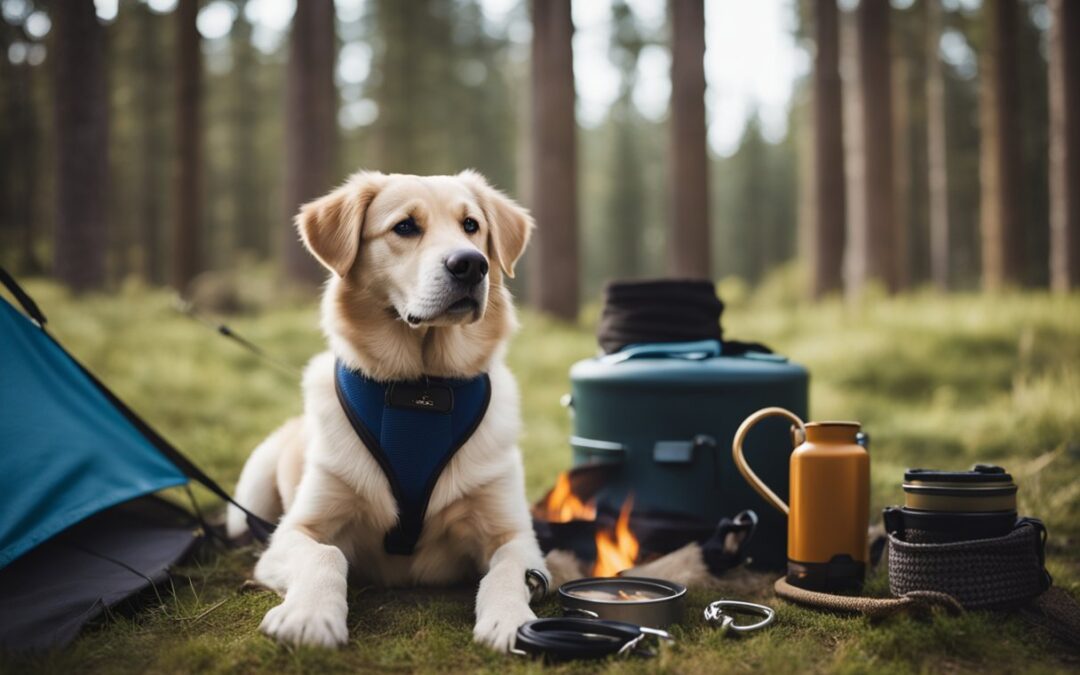
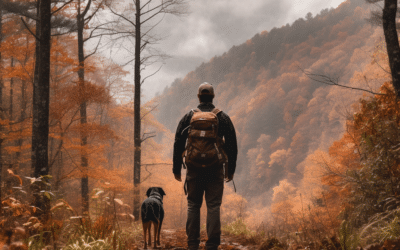
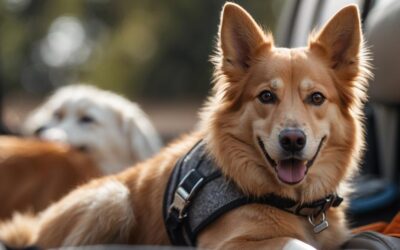
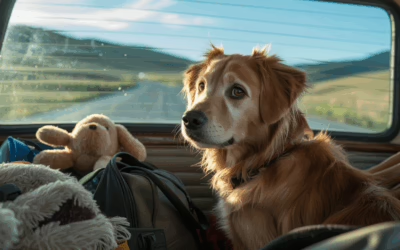
Recent Comments